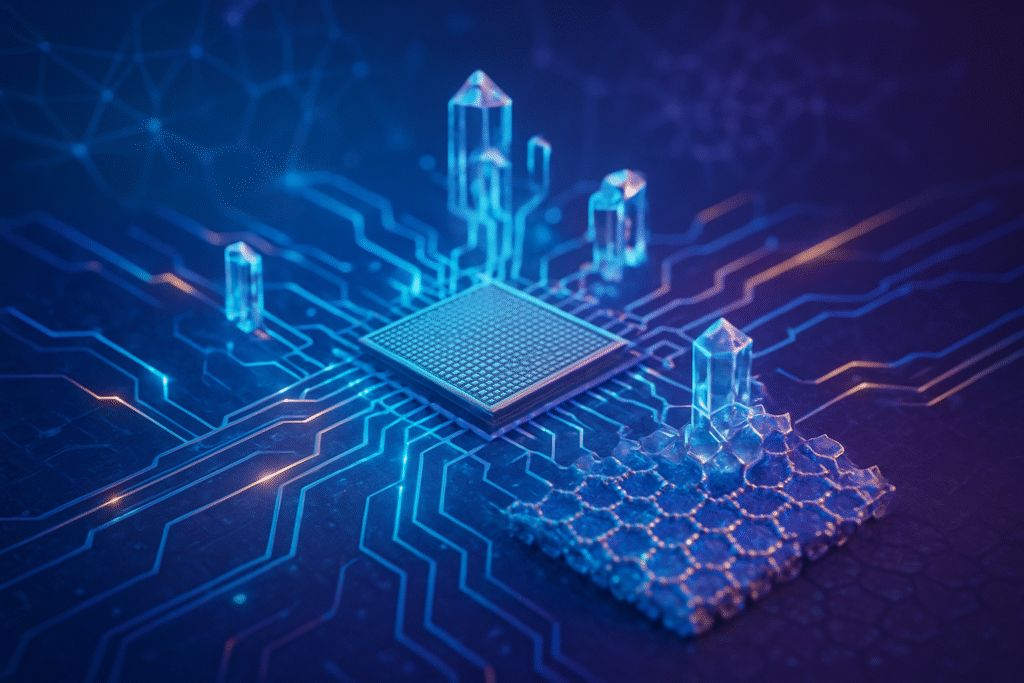
The foundational bedrock of the digital age, semiconductor technology, is currently experiencing a monumental transformation. As of October 2025, a confluence of groundbreaking material science and innovative architectural designs is pushing the boundaries of chip performance, promising an era of unparalleled computational power and energy efficiency. These advancements are not merely incremental improvements but represent a paradigm shift crucial for the escalating demands of artificial intelligence (AI), high-performance computing (HPC), and the burgeoning ecosystem of edge devices. The immediate significance lies in their ability to sustain Moore's Law well into the future, unlocking capabilities essential for the next wave of technological innovation.
The Dawn of a New Silicon Era: Technical Deep Dive into Breakthroughs
The quest for faster, smaller, and more efficient chips has led researchers and industry giants to explore beyond traditional silicon. One of the most impactful developments comes from Wide Bandgap (WBG) Semiconductors, specifically Gallium Nitride (GaN) and Silicon Carbide (SiC). These materials boast superior properties, including higher operating temperatures (up to 200°C for WBG versus 150°C for silicon), higher breakdown voltages, and significantly faster switching speeds—up to ten times quicker than silicon. This translates directly into lower energy losses and vastly improved thermal management, critical for power-hungry AI data centers and electric vehicles. Companies like Navitas Semiconductor (NASDAQ: NVTS) are already leveraging GaN to support NVIDIA Corporation's (NASDAQ: NVDA) 800 VDC power architecture, crucial for next-generation "AI factory" computing platforms.
Further pushing the envelope are Two-Dimensional (2D) Materials like graphene, molybdenum disulfide (MoS₂), and indium selenide (InSe). These ultrathin materials, merely a few atoms thick, offer superior electrostatic control, tunable bandgaps, and high carrier mobility. Such characteristics are indispensable for scaling transistors below 10 nanometers, where silicon's physical limitations become apparent. Recent breakthroughs include the successful fabrication of wafer-scale 2D indium selenide semiconductors, demonstrating potential for up to a 50% reduction in power consumption compared to silicon's projected performance in 2037. The integration of 2D flash memory chips made from MoS₂ into conventional silicon circuits also signals a significant leap, addressing long-standing manufacturing challenges.
Memory technology is also being revolutionized by Ferroelectric Materials, particularly those based on crystalline hafnium oxide (HfO2), and Memristive Semiconductor Materials. Ferroelectrics enable non-volatile memory states with minimal energy consumption, ideal for continuous learning AI systems. Breakthroughs in "incipient ferroelectricity" are leading to new memory solutions combining ferroelectric capacitors (FeCAPs) with memristors, forming dual-use architectures highly efficient for both AI training and inference. Memristive materials, which remember their history of applied current or voltage, are perfect for creating artificial synapses and neurons, forming the backbone of energy-efficient neuromorphic computing. These materials can maintain their resistance state without power, enabling analog switching behavior crucial for brain-inspired learning mechanisms.
Beyond materials, Advanced Packaging and Heterogeneous Integration represent a strategic pivot. This involves decomposing complex systems into smaller, specialized chiplets and integrating them using sophisticated techniques like hybrid bonding—direct copper-to-copper bonds for chip stacking—and panel-level packaging. These methods allow for closer physical proximity between components, shorter interconnects, higher bandwidth, and better power integrity. Taiwan Semiconductor Manufacturing Company (NYSE: TSM) (TSMC)'s 3D-SoIC and Broadcom Inc.'s (NASDAQ: AVGO) 3.5D XDSiP technology for GenAI infrastructure are prime examples, enabling direct memory connection to chips for enhanced performance. Applied Materials, Inc. (NASDAQ: AMAT) recently introduced its Kinex integrated die-to-wafer hybrid bonding system in October 2025, further solidifying this trend.
integrated die-to-wafer hybrid bonding system in October 2025, further solidifying this trend.
The rise of Neuromorphic Computing Architectures is another transformative innovation. Inspired by the human brain, these architectures emulate neural networks directly in silicon, offering significant advantages in processing power, energy efficiency, and real-time learning by tightly integrating memory and processing. Specialized circuit designs, including silicon neurons and synaptic elements, are being integrated at high density. Intel Corporation's (NASDAQ: INTC) Loihi chips, for instance, demonstrate up to a 1000x reduction in energy for specific AI tasks compared to traditional GPUs. This year, 2025, is considered a "breakthrough year" for neuromorphic chips, with devices from companies like BrainChip Holdings Ltd. (ASX: BRN) and IBM (NYSE: IBM) entering the market at scale.
Finally, advancements in Advanced Transistor Architectures and Lithography remain crucial. The transition to Gate-All-Around (GAA) transistors, which completely surround the transistor channel with the gate, offers superior control over current leakage and improved performance at smaller dimensions (2nm and beyond). Backside power delivery networks are also a significant innovation. In lithography, ASML Holding N.V.'s (NASDAQ: ASML) High-NA EUV system is launching by 2025, capable of patterning features 1.7 times smaller and nearly tripling density, indispensable for 2nm and 1.4nm nodes. TSMC anticipates high-volume production of its 2nm (N2) process node in late 2025, promising significant leaps in performance and power efficiency. Furthermore, Cryogenic CMOS chips, designed to function at extremely low temperatures, are unlocking new possibilities for quantum computing, while Silicon Photonics integrates optical components directly onto silicon chips, using light for neural signal processing and optical interconnects, drastically reducing power consumption for data transfer.
Competitive Landscape and Corporate Implications
These semiconductor breakthroughs are creating a dynamic and intensely competitive landscape, with significant implications for AI companies, tech giants, and startups alike. NVIDIA Corporation (NASDAQ: NVDA) stands to benefit immensely, as its AI leadership is increasingly dependent on advanced chip performance and power delivery, directly leveraging GaN technologies and advanced packaging solutions for its "AI factory" platforms. Taiwan Semiconductor Manufacturing Company (NYSE: TSM) (TSMC) and Intel Corporation (NASDAQ: INTC) are at the forefront of manufacturing innovation, with TSMC's 2nm process and 3D-SoIC packaging, and Intel's 18A process node (a 2nm-class technology) leveraging GAA transistors and backside power delivery, setting the pace for the industry. Their ability to rapidly scale these technologies will dictate the performance ceiling for future AI accelerators and CPUs.
The rise of neuromorphic computing benefits companies like Intel with its Loihi platform, IBM (NYSE: IBM) with TrueNorth, and specialized startups like BrainChip Holdings Ltd. (ASX: BRN) with Akida. These companies are poised to capture the rapidly expanding market for edge AI applications, where ultra-low power consumption and real-time learning are paramount. The neuromorphic chip market is projected to grow at approximately 20% CAGR through 2026, creating a new arena for competition and innovation.
In the materials sector, Navitas Semiconductor (NASDAQ: NVTS) is a key beneficiary of the GaN revolution, while companies like Ferroelectric Memory GmbH are securing significant funding to commercialize FeFET and FeCAP technology for AI, IoT, and embedded memory markets. Applied Materials, Inc. (NASDAQ: AMAT), with its Kinex hybrid bonding system, is a critical enabler for advanced packaging across the industry. Startups like Silicon Box, which recently announced shipping 100 million units from its advanced panel-level packaging factory, demonstrate the readiness of these innovative packaging techniques for high-volume manufacturing for AI and HPC. Furthermore, SemiQon, a Finnish company, is a pioneer in cryogenic CMOS, highlighting the emergence of specialized players addressing niche but critical areas like quantum computing infrastructure. These developments could disrupt existing product lines by offering superior performance-per-watt, forcing traditional chipmakers to rapidly adapt or risk losing market share in key AI and HPC segments.
hybrid bonding system, is a critical enabler for advanced packaging across the industry. Startups like Silicon Box, which recently announced shipping 100 million units from its advanced panel-level packaging factory, demonstrate the readiness of these innovative packaging techniques for high-volume manufacturing for AI and HPC. Furthermore, SemiQon, a Finnish company, is a pioneer in cryogenic CMOS, highlighting the emergence of specialized players addressing niche but critical areas like quantum computing infrastructure. These developments could disrupt existing product lines by offering superior performance-per-watt, forcing traditional chipmakers to rapidly adapt or risk losing market share in key AI and HPC segments.
Broader Significance: Fueling the AI Supercycle
These advancements in semiconductor materials and technologies are not isolated events; they are deeply intertwined with the broader AI landscape and are critical enablers of what is being termed the "AI Supercycle." The continuous demand for more sophisticated machine learning models, larger datasets, and faster training times necessitates an exponential increase in computing power and energy efficiency. These next-generation semiconductors directly address these needs, fitting perfectly into the trend of moving AI processing from centralized cloud servers to the edge, enabling real-time, on-device intelligence.
The impacts are profound: significantly enhanced AI model performance, enabling more complex and capable large language models, advanced robotics, autonomous systems, and personalized AI experiences. Energy efficiency gains from WBG semiconductors, neuromorphic chips, and 2D materials will mitigate the growing energy footprint of AI, a significant concern for sustainability. This also reduces operational costs for data centers, making AI more economically viable at scale. Potential concerns, however, include the immense R&D costs and manufacturing complexities associated with these advanced technologies, which could widen the gap between leading-edge and lagging semiconductor producers, potentially consolidating power among a few dominant players.
Compared to previous AI milestones, such as the introduction of GPUs for parallel processing or the development of specialized AI accelerators, the current wave of semiconductor innovation represents a fundamental shift at the material and architectural level. It's not just about optimizing existing silicon; it's about reimagining the very building blocks of computation. This foundational change promises to unlock capabilities that were previously theoretical, pushing AI into new domains and applications, much like the invention of the transistor itself laid the groundwork for the entire digital revolution.
The Road Ahead: Future Developments and Challenges
Looking ahead, the near-term and long-term developments in next-generation semiconductors promise even more radical transformations. In the near term, we can expect the widespread adoption of 2nm and 1.4nm process nodes, driven by GAA transistors and High-NA EUV lithography, leading to a new generation of incredibly powerful and efficient AI accelerators and CPUs by late 2025 and into 2026. Advanced packaging techniques will become standard for high-performance chips, integrating diverse functionalities into single, dense modules. The commercialization of neuromorphic chips will accelerate, finding applications in embedded AI for IoT devices, smart sensors, and advanced robotics, where their low power consumption is a distinct advantage.
Potential applications on the horizon are vast, including truly autonomous vehicles capable of real-time, complex decision-making, hyper-personalized medicine driven by on-device AI analytics, and a new generation of smart infrastructure that can learn and adapt. Quantum computing, while still nascent, will see continued advancements fueled by cryogenic CMOS, pushing closer to practical applications in drug discovery and materials science. Experts predict a continued convergence of these technologies, leading to highly specialized, purpose-built processors optimized for specific AI tasks, moving away from general-purpose computing for certain workloads.
However, significant challenges remain. The escalating costs of advanced lithography and packaging are a major hurdle, requiring massive capital investments. Material science innovation must continue to address issues like defect density in 2D materials and the scalability of ferroelectric and memristive technologies. Supply chain resilience, especially given geopolitical tensions, is also a critical concern. Furthermore, designing software and AI models that can fully leverage these novel hardware architectures, particularly for neuromorphic and quantum computing, presents a complex co-design challenge. What experts predict will happen next is a continued arms race in R&D, with increasing collaboration between material scientists, chip designers, and AI researchers to overcome these interdisciplinary challenges.
A New Era of Computational Power: The Unfolding Story
In summary, the current advancements in emerging materials and innovative technologies for next-generation semiconductors mark a pivotal moment in computing history. From the power efficiency of Wide Bandgap semiconductors to the atomic-scale precision of 2D materials, the non-volatile memory of ferroelectrics, and the brain-inspired processing of neuromorphic architectures, these breakthroughs are collectively redefining the limits of what's possible. Advanced packaging and next-gen lithography are the glue holding these disparate innovations together, enabling unprecedented integration and performance.
This development's significance in AI history cannot be overstated; it is the fundamental hardware engine powering the ongoing AI revolution. It promises to unlock new levels of intelligence, efficiency, and capability across every sector, accelerating the deployment of AI from the cloud to the farthest reaches of the edge. The long-term impact will be a world where AI is more pervasive, more powerful, and more energy-conscious than ever before. In the coming weeks and months, we will be watching closely for further announcements on 2nm and 1.4nm process node ramp-ups, the continued commercialization of neuromorphic platforms, and the progress in integrating 2D materials into production-scale chips. The race to build the future of AI is being run on the molecular level, and the pace is accelerating.
This content is intended for informational purposes only and represents analysis of current AI developments.
TokenRing AI delivers enterprise-grade solutions for multi-agent AI workflow orchestration, AI-powered development tools, and seamless remote collaboration platforms.
For more information, visit https://www.tokenring.ai/.





